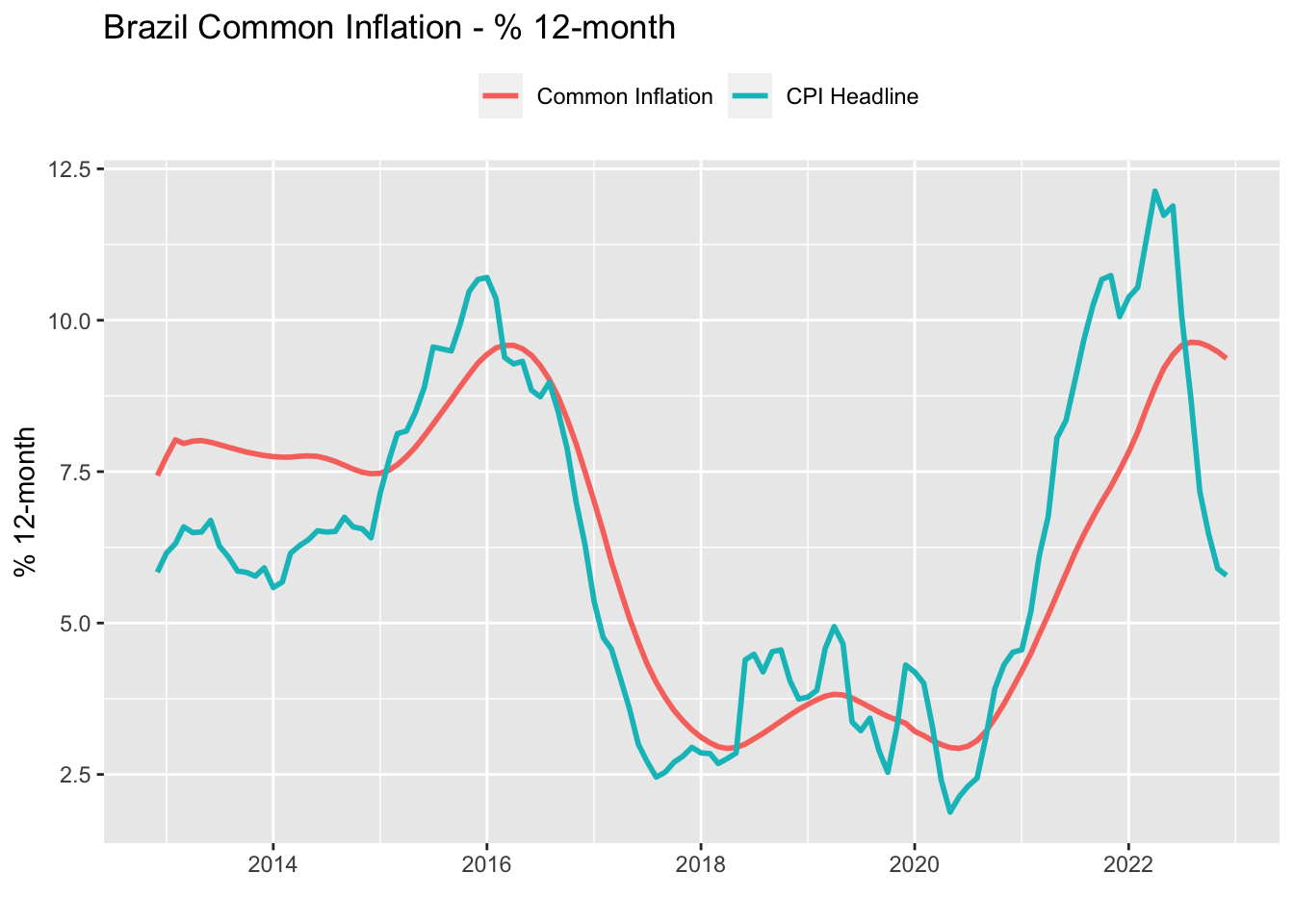# Define model's specification
model.spec <- list()
model.spec$B <- matrix(
list(
"b1", 1, 0, 0,
"b2", 0, 1, 0,
"b3", 0, 0, 1,
"b4", 0, 0, 0
), 4, 4)
model.spec$Z <- matrix(
list(0), nrow(CPI_ts), 4)
model.spec$Z[, 1] <- rownames(CPI_ts)
model.spec$Q <- "diagonal and equal"
model.spec$R <- "diagonal and unequal"
model.spec$A <- "zero"
# Estimate using the EM Algorithm
model.em <- MARSS(
CPI_ts,
model = model.spec,
inits = list(x0 = 0),
silent = TRUE
)14 Dynamic Factor Model
Policymakers and analysts are routinely seeking to characterize short-term fluctuation in prices as either persistent or temporary. This issue is often addressed using core measures that exclude those items that are the most volatile or most subject to supply shocks from the inflation index.
Eli, Flora, and Danilo (2021) argue that core measures are imperfect measures of underlying inflation in that temporary shocks in sectors that were not filtered out from the index may be misunderstood as economy-wide shocks.
The authors propose an alternative measure to deal with this problem. In their words:
“The basic assumption is that each component of the inflation index combines two driving forces. The first is a trend that is common across all components. The second comes from idiosyncratic components that capture one-off changes, sector-specific developments, and measurement errors.”
In fact, this idea is represented by a special class of State-Space models known as Dynamic Factor Model (DFM). In short, DFM allows us to estimate common underlying trends among a relatively large set of time series (see Holmes, Scheuerell, and Ward (2021), chapter 10). Using Eli, Flora, and Danilo (2021) notation, the model has the following structure:
14.1 Writing out the DFM as MARSS
We start by writing out the above DFM in MARSS form. The LHS of the observation equation contains now the
14.2 Importing data
For this exercise, we’ll use data on the 51 subsectors that make up Brazilian CPI. All these time series are the monthly percentage change accumulated in the last twelve months. This eliminates the need to add seasonal components to the model.Basically, the final output is
14.3 Estimating the model
Next, we declare the system matrices. Note that by defining the
14.4 Results
After estimating the system, we are ready to compute the common inflation component,
# Compute model's components
ft <- model.em$states[1, ]
names(ft) <- CPI_twelveMonths$date
ft_df <- ft %>%
as.data.frame() %>%
rownames_to_column() %>%
magrittr::set_colnames(c('date', 'ft'))
lambda <- model.em$par$Z %>%
as.data.frame() %>%
tibble::rownames_to_column() %>%
magrittr::set_colnames(c('item', 'lambda'))
chi_it <- lambda %>%
mutate(
chi_it = map(
.x = lambda,
.f = ~ {
df <- .x*ft %>%
as.data.frame()
df <- df %>%
rownames_to_column() %>%
magrittr::set_colnames(c('date', 'chi_it')) %>%
mutate(date = ymd(date))
}
)
) %>%
unnest(chi_it) %>%
left_join(
cpi_df$Weight %>%
rename(c('weight' = 'value'))
) %>%
relocate(date)
# Commpute the common trend
common_trend <- chi_it %>%
group_by(date) %>%
summarise("Common Inflation" = sum(chi_it*weight)/sum(weight)) %>%
ungroup() %>%
left_join(
CPI_twelveMonths %>%
select(date, `CPI Headline` = contains('CPI'))
)common_trend %>%
pivot_longer(-date, names_to = 'var', values_to = 'value') %>%
ggplot(aes(x = date)) +
geom_line(aes(y = value, color = var), lwd = 1) +
theme(legend.position = 'top') +
labs(
title = 'Brazil Common Inflation - % 12-month',
x = '',
y = '% 12-month',
color = ''
)